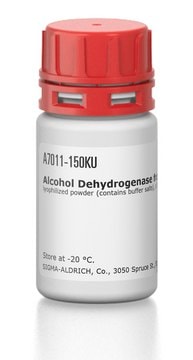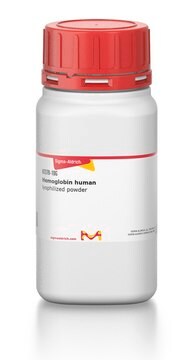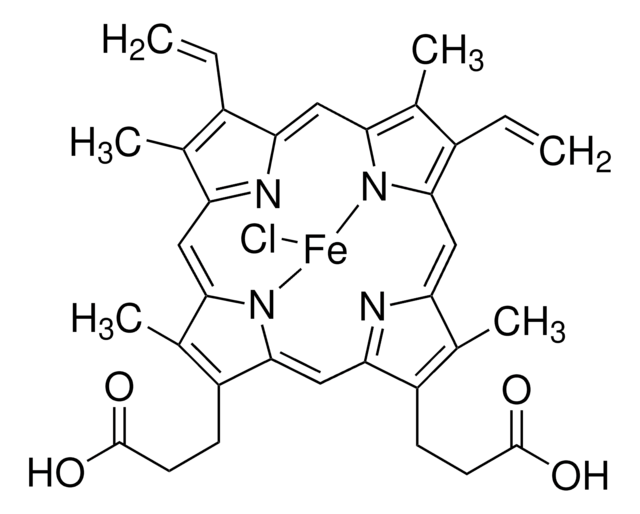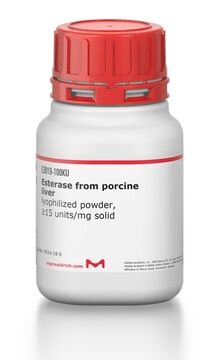추천 제품
생물학적 소스
fungus (Candida boidinii)
형태
lyophilized powder
특이 활성도
5.0-15.0 units/mg protein
구성
Protein, 5.0-20.0% biuret
저장 온도
2-8°C
유사한 제품을 찾으십니까? 방문 제품 비교 안내
애플리케이션
Formate Dehydrogenase (FDH) is used for diagnostics in large scale industrial processes. Its used in the production of an unnatural amino acid, tert-L-leucine, a component of some HIV protease and matrix metalloprotease inhibitors.
생화학적/생리학적 작용
Formate dehydrogenase is an abundant enzyme from yeast Candida boidinii (CbFDH) that plays an important role in the energy supply of methylotrophic microorganisms and in the stress response of plants.
Formate dehydrogenase is involved in the stress response of plants and catalyzes the reduction of NAD+ to NADH.
단위 정의
One unit will oxidize 1.0 μmole of formate to CO2 per min in the presence of β-NAD at pH 7.6 at 37 °C.
신호어
Danger
유해 및 위험 성명서
예방조치 성명서
Hazard Classifications
Resp. Sens. 1
Storage Class Code
11 - Combustible Solids
WGK
WGK 3
Flash Point (°F)
Not applicable
Flash Point (°C)
Not applicable
개인 보호 장비
Eyeshields, Gloves, type N95 (US)
시험 성적서(COA)
제품의 로트/배치 번호를 입력하여 시험 성적서(COA)을 검색하십시오. 로트 및 배치 번호는 제품 라벨에 있는 ‘로트’ 또는 ‘배치’라는 용어 뒤에서 찾을 수 있습니다.
이미 열람한 고객
Held in police custody.
A Skelt
Nursing times, 84(4), 50-52 (1988-01-02)
Jana Löwe et al.
Scientific reports, 8(1), 10436-10436 (2018-07-12)
A biotechnological process is reported, which enables an enzymatic reduction without the need for addition of an organic co-substrate for in situ-cofactor recycling. The process is based on merging the fields of enzymatic reductive amination with formate dehydrogenase-based in situ-cofactor
Frances L Shaw et al.
Journal of bacteriology, 194(15), 3814-3823 (2012-05-23)
The food-borne bacterial pathogen Campylobacter jejuni efficiently utilizes organic acids such as lactate and formate for energy production. Formate is rapidly metabolized via the activity of the multisubunit formate dehydrogenase (FDH) enzyme, of which the FdhA subunit is predicted to
Yutaka Amao et al.
Faraday discussions, 155, 289-296 (2012-04-05)
Solar fuels, such as hydrogen gas produced from water and methanol produced from carbon dioxide reduction by artificial photosynthesis, have received considerable attention. In natural leaves the photosynthetic proteins are well-organized in the thylakoid membrane. To develop an artificial leaf
Mark Pryjma et al.
Journal of bacteriology, 194(15), 3803-3813 (2012-05-29)
Campylobacter jejuni is a food-borne bacterial pathogen that colonizes the intestinal tract and causes severe gastroenteritis. Interaction with host epithelial cells is thought to enhance severity of disease, and the ability of C. jejuni to modulate its metabolism in different
자사의 과학자팀은 생명 과학, 재료 과학, 화학 합성, 크로마토그래피, 분석 및 기타 많은 영역을 포함한 모든 과학 분야에 경험이 있습니다..
고객지원팀으로 연락바랍니다.









